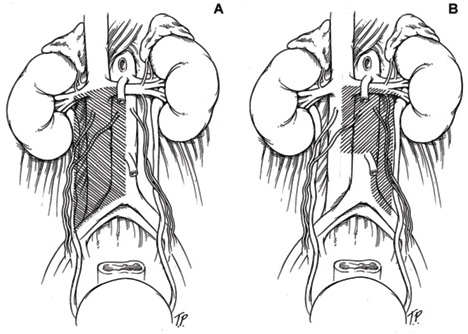Retroperitoneal Lymph Node Dissection
As the testicles form and develop near the kidneys in a fetus, the blood supply, lymphatic drainage and nerves to the testicle originate near the kidney on that side. Therefore, testis cancer has a very predictable pattern of spread. The primary landing zone for metastases from testis cancer is the lymph nodes of the retroperitoneum — the area around and between the aorta and inferior vena cava at the level of the kidneys.
Therefore, retroperitoneal lymph node dissection (RPLND) is an important surgical option for men with testis cancer. Given the complexities of this type of surgery, it is important that RPLNDs be performed at experienced centers.

A.Template dissection limits for right-sided tumors consist of ureter (lateral), midpoint of aorta (medial), bifurcation of iliac vessels (inferior) and renal hilum (superior).B. Template dissection limits for left-sided tumors consist of ureter (lateral), midpoint of vena cava (medial), bifurcation of iliac vessels (distal) and renal hilum (superior).
Primary RPLND
Traditionally, RPLND is done through a large, midline incision (along the entire abdomen) and only performed at high-volume centers of excellence due to the rarity of disease and technical challenges of the surgery. More recently, minimally invasive RPLND has been explored as an option in selected scenarios in an attempt to hasten post-operative recovery. In patients without metastases (clinical stage I) or low-burden lymph node metastases (clinical stage II), RPLND offers the advantage of pathologic staging for diagnosis, treating or “controlling” the retroperitoneum by removing all of the lymph nodes at risk of harboring metastasis, and preventing new metastases from arising in the so-called landing zones.
Post-Chemotherapy RPLND
In many situations, particularly those with more advanced disease, patients receive chemotherapy rather than an RPLND. For some men treated with chemotherapy, lymph nodes in the retroperitoneum will not respond to chemotherapy or slowly grow after a period of shrinkage. In these cases, the retroperitoneal mass can be a viable tumor (10–15%) or teratoma (40–50%). Teratoma in the retroperitoneum is not responsive to chemotherapy and will continue to grow until it compresses a vital structure like the inferior vena cava or intestines — a process called growing teratoma syndrome.
In these cases, if the serum tumor markers are normal, then there may be a role for performing surgery (RPLND) post-chemotherapy to remove cancer not adequately treated by chemotherapy.
A post-chemotherapy RPLND is an extremely challenging surgery. Chemotherapy can cause lymph nodes in the retroperitoneum to fuse to important surrounding structures including the aorta, vena cava, intestines and kidneys. Safely removing the cancerous lymph nodes involves precise dissection and often removal of adjacent organs rather than risk major vascular or bowel injury. Most post-chemotherapy RPLNDs are performed in a team approach, with vascular, general and thoracic surgeons available on a case-by-case basis. The surgery most often involves a large incision along the entire length of the abdomen and a hospital stay of three to five days. Recovery can take as long as two to four weeks before feeling 100%. However, post-chemotherapy RPLND can be a lifesaving surgery and, when performed at expert centers, has excellent outcomes.
RPLND Complications
The complication rate for a primary RPLND is about 5% and about 15% for a post-chemotherapy RPLND. Serious complications are rare (less than 2%) and include:
- Anejaculation
- Serious bleeding requiring blood transfusion
- Lymphatic leak (chylous ascites)
Anejaculation
The nerves that control ejaculation (expulsion of fluid from the penis during orgasm) lie in the retroperitoneum. Sympathetic nerves control ejaculation and run lateral and parallel to the great vessels before converging at the base of the aorta (where it branches to form the iliac arteries) before traveling to the seminal vesicles, vas deferens, prostate and bladder neck.
Anejaculation is the inability to ejaculate. With nerve-sparing techniques, the rates of anejaculation are 5–10% for primary RPLND. The rates of anejaculation are higher for post-chemotherapy RPLND as the nerves cannot always be spared to remove cancer.
Serious Bleeding
Serious bleeding occurs in less than 2% of cases. However, bleeding from the aorta or vena cava can require blood transfusion and be potentially life-threatening. In cases where retroperitoneal lymph nodes appear close or adherent to the aorta or vena cava, it is often safer to surgically remove a portion of the blood vessel. Depending on the size of the tumor and complexity of the repair, a vascular surgeon may be a part of the operative team.
Lymphatic Leak (Chylous Ascites)
As the lymphatic channels in the retroperitoneum are interrupted, rarely a lymphatic leak can occur. Your surgeon will use a variety of intraoperative techniques to prevent lymphatic leak. In addition, as lymphatic fluid is “fueled” by fatty foods, a nutritionist will teach you about a low-fat diet and how to slowly resume a normal diet over the weeks following surgery.
Chylous ascites almost always resolves within a few weeks to months, but can be problematic to treat. Treatments for chylous ascites include restricted diet, placement of abdominal drains (or intermittent drainage), medications to decrease the amount of lymphatic fluids or interventional radiology procedures. Johns Hopkins is an expert center in treating refractory chylous ascites with lymphangiography and sclerotherapy. Surgery is a last resort in rare cases.




